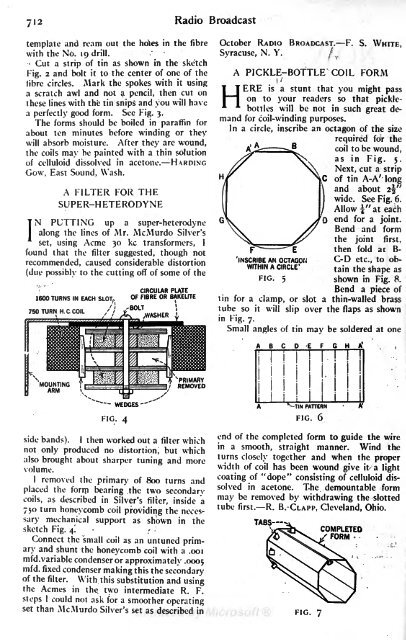Radio Broadcast - 1925, February - 113 Pages ... - VacuumTubeEra
Radio Broadcast - 1925, February - 113 Pages ... - VacuumTubeEra
Radio Broadcast - 1925, February - 113 Pages ... - VacuumTubeEra
Create successful ePaper yourself
Turn your PDF publications into a flip-book with our unique Google optimized e-Paper software.
i Cut<br />
I<br />
1<br />
712 <strong>Radio</strong> <strong>Broadcast</strong><br />
template and ream out the holes in the fibre<br />
with the No. 19 drill.<br />
a strip of tin as shown in the sketch<br />
Fig. 2 and bolt it to the center of one of the<br />
fibre circles. Mark the spokes with it using<br />
a scratch awl and not a pencil, then cut on<br />
these lines with the tin snips and you will have<br />
a perfectly good form. Sec Fig. 3.<br />
The forms should be boiled in paraffin for<br />
about ten minutes before winding or they<br />
will absorb moisture. After they are wound,<br />
the coils may be painted with a thin solution<br />
of celluloid dissolved in acetone. HARDING<br />
Cow, East Sound, Wash.<br />
IN<br />
A FILTER FOR THE<br />
SUPER-HETERODYNE<br />
PUTTING up a super-heterodyne<br />
along the lines of Mr. McMurdo Silver's<br />
set, using Acme 30 kc transformers, 1<br />
found that the filter suggested, though not<br />
recommended, caused considerable distortion<br />
(due possibly to the cutting off of some of the<br />
CIRCULAR PLATE<br />
1600 TURNS IN EACH SLOT. OF FIBRE OR BAKELITE<br />
f\ \<br />
750 TURN H.CCOIL<br />
October RADIO BROADCAST. F. S. WHITE,<br />
Syracuse, N. Y.<br />
A PICKLE-BOTTLE COIL<br />
B<br />
FORM<br />
HERE is a stunt that you might pass<br />
on to your readers so that picklebottles<br />
will be not in such great demand<br />
for coil-winding purposes.<br />
In a circle, inscribe an octagon of the size<br />
H<br />
'INSCRIBE AN OCTAGON<br />
WITHIN A CIRCLE'<br />
FIG.<br />
S<br />
required for the<br />
coil to be wound,<br />
as in Fig. 5 .<br />
Next, cut a strip<br />
C of tin A-A' long<br />
\ and about 2f"<br />
I<br />
wide. See Fig. 6.<br />
Allow \" at each<br />
end for a joint.<br />
Bend and form<br />
the joint first,<br />
then fold ac B-<br />
C-D etc., to obtain<br />
the shape as<br />
shown in Fig. 8.<br />
Bend a piece of<br />
tin for a clamp, or slot a thin-walled brass<br />
tube so it will slip over the flaps as shown<br />
in Fig. 7.<br />
Small angles of tin<br />
may<br />
be soldered at one<br />
A B C D E F G H A*<br />
FIG. 4<br />
side bands).<br />
I then worked out a filter which<br />
not only produced no distortion, but which<br />
also brought about sharper tuning and more<br />
volume.<br />
I removed the primary of 800 turns and<br />
placed the form bearing the two secondary<br />
coils, as described in Silver's filter, inside a<br />
750 turn honeycomb coil providing the necessary<br />
mechanical support as shown in the<br />
sketch Fig. 4.<br />
Connect the small coil as an untuned primary<br />
and shunt the honeycomb coil with a .001<br />
mfd. variable condenser or approximately .0005<br />
mfd. fixed condenser making this the secondary<br />
of the filter. With this substitution and using<br />
the Acmes in the two intermediate R. F.<br />
steps I<br />
could not ask for a smoother operating<br />
set than McMurdo Silver's set as described in
















